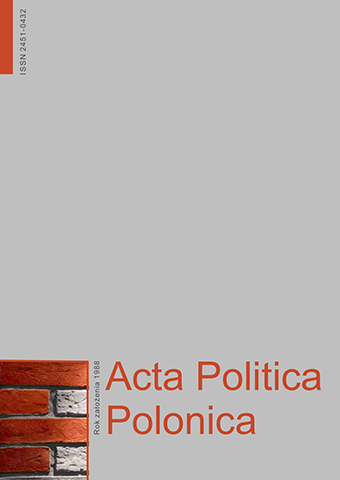
ISSN: 2451-0432
eISSN: 2719-4388
OAI
DOI: 10.18276/ap.2022.53-01




Lista wydań /
1/2022 (53)
Proliferation of illicit arms and control mechanisms in Nigeria: A critical socioeconomic analysis
| Autorzy: |
Olagoke Oluwafemi
Awotayo

Department of Political Sciences, Osun State University, Nigeria Olawale Olufemi Akinrinde 
Department of Political Sciences, Osun State University, Nigeria Olowogboyega Oyebade 
Department of Public Law, Osun State University, Nigeria |
| Słowa kluczowe: | arms proliferation control initiatives insecurity Nigeria |
| Data publikacji całości: | 2022 |
| Liczba stron: | 10 (5-14) |
Abstrakt
The study addresses the question of illicit weapons proliferation and many diverse control measures undertaken to counteract it in Nigeria. It further explores the reasons why Nigeria has become an appealing target for illicit weapons in the West African sub-region. Given the ease of in-flows and out-flows of illicit arms within the borders of the Nigerian State, this study contends that Nigeria’s firearms law is outdated and insufficient, especially as seen from the perspective of the Protocol to the arms trade agreement that is in force, and even in the light of the dynamics of security issues in the 21st century. The study demonstrates that the growing proliferation of illicit weapons in Nigeria has had economic, humanitarian and socio-political consequences. Therefore, it concludes that all the regional containment measures, from ECOWAS to weapons trading agreements, have not decreased the proliferation of illicit arms in Nigeria and that the Nigeria’s Firearms Act is outdated and unsuitable for the security needs of the Nigerian state, notwithstanding the problems faced by the security dynamics of the 21st century.
Pobierz plik
Plik artykułu
Bibliografia
| 1. | Adeniyi, A. (2017). The human cost of uncontrolled arms in Africa: Cross-national research on seven African countries. Oxfam Research Reports, March issue. |
| 2. | Alusala, N. (2016). Control initiatives in Africa: Lessons from small and light weapons. Working Paper 1. Awotayo, G., Oladipo, S., Ilelah, K. (2013). Nigeria quasi federalism: An obstacle to peace and development in Nigeria. International Journal of Humanities and Social Science Invention, 2 (8). |
| 3. | Ayissi, A., Sall, I. (2005). Combating the proliferation of small arms and light weapons in West Africa. Handbook for the training of armed and security forces. Geneva: United Nations Institute for Disarmament Research. |
| 4. | Banko, O.H. (2016). Global trends in arms proliferation in third world countries and the impending apocalypse of the human race: A case study of arms race and security challenges in Nigeria. International Journal of Innovative Research & Development, 5 (9). |
| 5. | British Broadcasting Cooperation News (2013). Nigeria: President Buhari has ordered the military to shoot on sight on anyone seen with AK-47 rifle in the bush. |
| 6. | Centre for Democracy and Development (2003). Briefing on Nigeria’s 2003 Elections. London. Retrieved from: http:// www.cdd.org.uk/resources/elections/Briefing_Nig_Elections.htm (05.03.2021). |
| 7. | Chinwokwu, E.C. (2013). The Challenges of conflict management in a democratic society: An overview of insecurity in Nigeria. American International Journal of Social Science, 2 (3). |
| 8. | Duquet, N. (2009). Arms acquisition patterns and the dynamics of armed conflict: Lessons from the Niger Delta. International Studies Perspectives, 10, 169-85. |
| 9. | ECOWAS Commission (2010). Meeting of Ministers of Defence and Security to review and adopt the plan of action for the implementation of ECOWAS Convention on Small Arms and Light Weapons and the Exemption Request Form to the Convention. Meeting Report, Abuja: ECOWAS. |
| 10. | ECOWAS Small Arms Control Programme (ECOSAP) (2007). Programme to tackle the illicit proliferation of small arms and light weapons. In: ECOWAS States Programme Document. |
| 11. | Geneva Declaration on Armed Violence and Development, Vol. 2 (2011). Cambridge: Cambridge University Press. |
| 12. | Hazen, J.M., Horner, J. (2007). Small arms, armed violence, and insecurity in Nigeria: The Niger Delta in perspective. Small Arms Survey Occasional Paper, 20. |
| 13. | Hilde, W., Harang, A. (2011). Small but lethal: Small Arms Ammunitions and Arms Trade Treaty. Oslo: PRIO. |
| 14. | Ikelegbe, A. (2010). Trafficking of small arms and light weapon (SALW) in West Africa: Route and illegal arm caches between Ghana, Togo, Benin, and Nigeria. Abuja: Friedrich-Ebert-Stiftung. |
| 15. | Iro, I. (1994). The Fulani herding system. Washington: African Development Foundation. |
| 16. | Kamavauko, L., Luvenga, M. (1995). Arms export to Zaire and trade of Zaire women in Belgium. Hanover: GAMA. |
| 17. | Moses, J.M., Ngomba, J.L. (2017). Small arms and light weapons proliferation in the early 21st century: The Nigerian case. International Journal of Development and Sustainability, 6 (11), 1638-1652. |
| 18. | Omitola, B. Awotayo, G. (2016). Arms proliferation and challenges of national security and sustainable development in Nigeria. Journal of Sustainable Development in Africa, 18 (2). |
| 19. | Pokoo, J. (2013). Arms control in peacebuilding activities in Africa: A perspective. Retrieved from: https://www.vanguardngr. com/2016/08/nigeria-accounts-70-illicit-weapons-wafrica/ (4.06.2021). |
| 20. | The Nations Newspaper (2018). Editorial. 23 February. |
| 21. | UNODA (2013). The impact of poorly regulated arms transfers on the work of the United Nations. United Nations Coordinating Action on Small Arms (CASA). Occasional Papers, 23. |
| 22. | Yacubu, G. (2005). Cooperation among armed forces and security forces in combating the proliferation of small arms. In: A. Ayissi, I. Sall (eds.), Combating the proliferation of small arms and light weapons in West Africa. Handbook for the training of armed and security forces, 55-69. Geneva: United Nations Institute for Disarmament Research. |